Renewable Generation and Transmission Expansion Planning Coordination with Energy Storage System: A Flexibility Point of View
Abstract
:1. Introduction
1.1. Motivation and Approach
1.2. Literature Review
1.3. Contributions
- None of the previous studies on CNEP consider the flexibility index of power systems. However, it is important in a power system in the presence of RESs to modify the generation injection and/or consumption patterns that are not suitable from a power balancing viewpoint due to the uncertainties of RESs. This index can be improved in the power system using the optimal planning of energy storage systems such as batteries.
- Many research works reviewed above take into account DC power flow constraints in their CNEP models. This simplification results in the elimination of reactive power studies in an expansion planning problem. It should be noted that the capacity of lines and power sources also depends on the reactive power as well as the active power, and without considering the reactive power, the CNEP solution may lead to impractical results.
- Some works use evolutionary methods to solve the CNEP problem. These methods search for different directions of the solution space, and their progress is usually slow. Therefore, the computation time of evolutionary methods is high. In addition, their convergence to the global optimum for the CNEP problem cannot be guaranteed.
- Modeling the coordinated network expansion planning in the power system according to a hybrid method of optimal planning of renewable and flexible sources and TEP to improve the operation and the flexibility indices.
- Obtaining the linear model of the proposed strategy, considering the least calculation error concerning the original method using linearized AC optimal power flow equations.
- Using scenario-based stochastic programming based on a hybrid approach with the roulette wheel mechanism and Kantorovich method to model the uncertainty of the load, the energy price, and the RES power.
1.4. Paper Organization
2. Problem Formulation
2.1. Stochastic CNEP Problem
2.2. The Linear CNEP Model
- The difference in the voltage phases of the two ends of a transmission line is under 6 degrees or 0.105 radians.
- Since the magnitude of bus voltages in the transmission network should be between 0.95 and 1.05 per unit, the magnitude of bus voltages is very close to 1 per unit.
2.3. Uncertainties Model
3. Numerical Results and Discussion
3.1. IEEE 6-Bus Test System
- Modeling of the TEP problem based on DC power flow equations (DCTEP) as an MILP problem.
- Modeling of the TEP problem based on nonlinear AC power flow equations (NACTEP) as an MINLP problem.
- Modeling of the TEP problem based on the linear approximation of AC power flow equations (LACTEP) as an MILP problem.
- Case I: The stochastic TEP method based on the linear AC power flow.
- Case II: The stochastic linear AC power flow-based CNEP (LAC-CNEP) method, considering renewable sources and the planning of transmission lines.
- Case III: The proposed stochastic LAC-CNEP method that is formulated in (29)–(31).
- Reduce the operation cost: The operation cost in case II is 3,045,670 $, a reduction of 9.57% with respect to the TEP model. This term is 13.13% for the coordinated renewable sources and transmission expansion planning method.
- Reduce the investment cost: In the proposed CNEP method (case III), there is one constructed line that is between busses 2 and 6, while the TEP model includes two constructed lines.
- Improve the voltage profile: In case III, the maximum voltage drop is 0.053 p.u., while it is 0.065 and 0.059 p.u. in cases I and II, respectively. Therefore, the CNEP strategy can improve the voltage profile by about 18.46%.
- Obtain high flexibility: Based on Table 7, the CNEP method includes system flexibility of 10.93 as well as 0.2186 million $ flexibility benefit, where it is high concerning cases I and II.
3.2. IEEE 24-Bus Network
4. Conclusions
Author Contributions
Funding
Institutional Review Board Statement
Informed Consent Statement
Data Availability Statement
Conflicts of Interest
Nomenclature
| ch, dch | Binary variable of charging and discharging state inflexible source (without unit) |
| E | Stored energy in the flexible source |
| F+, F− | Upward and downward flexibility active power |
| PFch, PFdch | Charging and discharging active power of flexible source |
| PG, QG | Active and reactive power of generation unit |
| PL, QL | Active and reactive power flow of line |
| PR | Active power of RES |
| SF | System flexibility (without unit) |
| V, ΔV, θ | Magnitude, deviation, and angle (in radian) of voltage |
| x, xR, xF | The binary variable of line, RES, and flexible source construction (without unit) |
| A | Bus incidence matrix (if a line existed between buses i and j, Ab,j is equal to 1, or otherwise zero) |
| C | Energy or operation price in $/MWh |
| CF | Coincidence factor |
| Eini | Initial energy of flexible source in p.u. |
| Emin, Emax | Minimum and maximum energy of flexible source in p.u. |
| FC | Flexibility price ($) |
| g, b | Conductance and susceptance of a line in p.u. |
| ICL, ICR, ICF | Investment cost of line, RES, and flexible source in $ |
| PD, QD | Active and reactive load in p.u. |
| PFmax | Maximum charge/discharge rate in p.u. |
| PRmax | Maximum RES active power in p.u. |
| Vmin, Vmax | Minimum and maximum value of voltage magnitude in p.u. |
| SLmax | Maximum capacity of line in p.u. |
| SGmax | Maximum capacity of generation unit in p.u. |
| ρ | Probability of scenario |
| λ | Energy price ($/MWh) |
| ηch, ηdch | Charging and discharging efficiency of flexible source |
| (i, j), t, y, ω, k | Indices of bus, time, year, scenario, linearization segments of circular constraint |
| ϕi, ϕt, ϕy, ϕω, ϕk | Sets of bus, time, year, scenario, linearization segments of circular constraint |
References
- Jahannoosh, M.; Nowdeh, S.A.; Naderipour, A.; Kamyab, H.; Davoodkhani, I.F.; Klemeš, J.J. New Hybrid Meta-Heuristic Algorithm for Reliable and Cost-Effective Designing of Photovoltaic/Wind/Fuel Cell Energy System Considering Load Interruption Probability. J. Clean. Prod. 2020, 278, 123406. [Google Scholar] [CrossRef]
- Naderipour, A.; Abdul-Malek, Z.; Miveh, M.R.; Moghaddam, M.J.H.; Kalam, A.; Gandoman, F.H. A harmonic compensation strategy in a grid-connected photovoltaic system using zero-sequence control. Energies 2018, 11, 2629. [Google Scholar] [CrossRef] [Green Version]
- Naderipour, A.; Kalam, A.; Abdul-Malek, Z.; Davoudkhani, I.F.; Bin Mustafa, M.W.; Guerrero, J.M. An Effective Algorithm for MAED Problems with a New Reliability Model at the Microgrid. Electronics 2021, 10, 257. [Google Scholar] [CrossRef]
- Arabi-Nowdeh, S.; Nasri, S.; Saftjani, P.B.; Naderipour, A.; Abdul-Malek, Z.; Kamyab, H.; Nowdeh, A.J. Multi-criteria optimal design of hybrid clean energy system with battery storage considering off- and on-grid application. J. Clean. Prod. 2021, 290, 125808. [Google Scholar] [CrossRef]
- Fu, C.; Zhang, S.; Chao, K.-H. Energy Management of a Power System for Economic Load Dispatch Using the Artificial Intelligent Algorithm. Electronics 2020, 9, 108. [Google Scholar] [CrossRef] [Green Version]
- Bozorgavari, S.A.; Aghaei, J.; Pirouzi, S.; Vahidinasab, V.; Farahmand, H.; Korpås, M. Two-stage hybrid stochastic/robust optimal coordination of distributed battery storage planning and flexible energy management in smart distribution network. J. Energy Storage 2019, 26, 100970. [Google Scholar] [CrossRef]
- Alizadeh, B.; Jadid, S. Reliability constrained coordination of generation and transmission expansion planning in power systems using mixed integer programming. IET Gener. Transm. Distrib. 2011, 5, 948–960. [Google Scholar] [CrossRef]
- Jenabi, M.; Ghomi, S.F.; Smeers, Y. Bi-Level Game Approaches for Coordination of Generation and Transmission Expansion Planning Within a Market Environment. IEEE Trans. Power Syst. 2013, 28, 2639–2650. [Google Scholar] [CrossRef]
- Pozo, D.; Sauma, E.E.; Contreras, J. A three-level static MILP model for generation and transmission expansion planning. IEEE Trans. Power Syst. 2013, 28, 202–210. [Google Scholar] [CrossRef]
- Zhang, H.; Heydt, G.T.; Vittal, V.; Mittelmann, H.D. Transmission expansion planning using an ac model: Formulations and possible relaxations. In Proceedings of the 2012 IEEE Power and Energy Society General Meeting, San Diego, CA, USA, 22–26 July 2012; pp. 1–8. [Google Scholar] [CrossRef]
- Zhang, H.; Vittal, V.; Heydt, G.T.; Quintero, J. A Mixed-Integer Linear Programming Approach for Multi-Stage Security-Constrained Transmission Expansion Planning. IEEE Trans. Power Syst. 2011, 27, 1125–1133. [Google Scholar] [CrossRef]
- Santiago, P.T.; Carlos, A.C. Expansion planning for smart transmission grids using AC model and shunt compensation. IET Gener. Transm. Distrib. 2014, 8, 966–975. [Google Scholar]
- Alhamrouni, I.; Khairuddin, A.; Ferdavani, A.K.; Salem, M. Transmission expansion planning using AC-based differential evolution algorithm. IET Gener. Transm. Distrib. 2014, 8, 1637–1644. [Google Scholar] [CrossRef]
- Aghaei, J.; Amjady, N.; Baharvandi, A.; Akbari, M.-A. Generation and Transmission Expansion Planning: MILP–Based Probabilistic Model. IEEE Trans. Power Syst. 2014, 29, 1592–1601. [Google Scholar] [CrossRef]
- Mavalizadeh, H.; Ahmadi, A.; Heidari, A. Probabilistic multi-objective generation and transmission expansion planning problem using normal boundary intersection. IET Gener. Transm. Distrib. 2015, 9, 560–570. [Google Scholar] [CrossRef]
- Chen, B.; Wang, J.; Wang, L.; He, Y.; Wang, Z. Robust Optimization for Transmission Expansion Planning: Minimax Cost vs. Minimax Regret. IEEE Trans. Power Syst. 2014, 29, 3069–3077. [Google Scholar] [CrossRef]
- Moreira, A.; Pozo, D.; Street, A.; Sauma, E. Reliable renewable generation and transmission expansion planning: Co-optimization system’s resources for meeting renewable targets. IEEE Trans. Power Syst. 2017, 32, 3246–3257. [Google Scholar] [CrossRef]
- Hong, S.; Cheng, H.; Zeng, P. N-K Constrained Composite Generation and Transmission Expansion Planning With Interval Load. IEEE Access 2017, 5, 2779–2789. [Google Scholar] [CrossRef]
- Ahmadi, A.; Mavalizadeh, H.; Zobaa, A.F.; Shayanfar, H.A. Reliability-based model for generation and transmission expansion planning. IET Gener. Transm. Distrib. 2017, 11, 504–511. [Google Scholar] [CrossRef] [Green Version]
- Saxena, K.; Bhakar, R. Impact of LRIC pricing and demand response on generation and transmission expansion planning. IET Gener. Transm. Distrib. 2019, 13, 679–685. [Google Scholar] [CrossRef]
- Hamidpour, H.; Aghaei, J.; Dehghan, S.; Pirouzi, S.; Niknam, T. Integrated resource expansion planning of wind integrated power systems considering demand response programmes. IET Renew. Power Gener. 2019, 13, 519–529. [Google Scholar] [CrossRef]
- Najjar, M.; Falaghi, H. Wind-integrated simultaneous generation and transmission expansion planning considering short-circuit level constraint. IET Gener. Transm. Distrib. 2019, 13, 2808–2818. [Google Scholar] [CrossRef]
- Roldán, C.; Mínguez, R.; García-Bertrand, R.; Arroyo, J.M. Robust Transmission Network Expansion Planning under Correlated Uncertainty. IEEE Trans. Power Syst. 2019, 34, 2071–2082. [Google Scholar] [CrossRef]
- Huang, S.; Dinavahi, V. A Branch-and-Cut Benders Decomposition Algorithm for Transmission Expansion Planning. IEEE Syst. J. 2017, 13, 659–669. [Google Scholar] [CrossRef]
- Motie, S.; Keynia, F.; Ranjbar, M.R.; Maleki, A. Generation expansion planning by considering energy-efficiency programs in a competitive environment. Int. J. Electr. Power Energy Syst. 2016, 80, 109–118. [Google Scholar] [CrossRef]
- Nemati, H.; Latify, M.A.; Yousefi, G.R. Tri-level transmission expansion planning under intentional attacks: Virtual attacker approach—Part I: Formulation. IET Gener. Transm. Distrib. 2019, 13, 390–398. [Google Scholar] [CrossRef]
- Aghaei, J.; Barani, M.; Shafie-khah, M.; Sanchez de la Nieta, A.A.; Catalão, J.P.S. Risk-constrained offering strategy for aggregated hybrid power plant including wind power producer and demand response provider. IEEE Trans. Sustain. Energy 2016, 7, 513–525. [Google Scholar] [CrossRef]
- Zhang, Y.; Dong, Z.Y.; Luo, F.; Zheng, Y.; Meng, K.; Wong, K.P. Optimal allocation of battery energy storage systems in distribution networks with high wind power penetration. IET Renew. Power Gener. 2016, 10, 1105–1113. [Google Scholar] [CrossRef]
- Helistö, N.; Kiviluoma, J.; Holttinen, H. Long-term impact of variable generation and demand side flexibility on thermal power generation. IET Renew. Power Gener. 2018, 12, 718–726. [Google Scholar] [CrossRef]
- Zhang, W.; Maleki, A.; Rosen, M.A. A heuristic-based approach for optimizing a small independent solar and wind hybrid power scheme incorporating load forecasting. J. Clean. Prod. 2019, 241, 117920. [Google Scholar] [CrossRef]
- Maleki, A. Modeling and optimum design of an off-grid PV/WT/FC/diesel hybrid system considering different fuel prices. Int. J. Low Carbon Technol. 2018, 13, 140–147. [Google Scholar] [CrossRef]
- Conejo, A.J.; Baringo, L.; Kazempour, S.J.; Siddiqui, A.S. Investment in Electricity Generation and Transmission; Springer: Cham, Switzerland, 2016. [Google Scholar]
- Pirouzi, S.; Aghaei, J. Mathematical modeling of electric vehicles contributions in voltage security of smart distribution networks. Simulation 2018, 95, 429–439. [Google Scholar] [CrossRef]
- Pirouzi, S.; Aghaei, J.; Latify, M.A.; Yousefi, G.R.; Mokryani, G. A Robust Optimization Approach for Active and Reactive Power Management in Smart Distribution Networks Using Electric Vehicles. IEEE Syst. J. 2017, 12, 2699–2710. [Google Scholar] [CrossRef] [Green Version]
- Pirouzi, S.; Aghaei, J.; Shafie-khah, M.; Osório, G.J.; Catalão, J.P.S. Evaluating the security of electrical energy distribution networks in the presence of electric vehicles. In Proceedings of the IEEE PowerTech Conference, Manchester, UK, 18–22 June 2017; pp. 1–6. [Google Scholar]
- Pirouzi, S.; Aghaei, J.; Niknam, T.; Farahmand, H.; Korpås, M. Proactive operation of electric vehicles in harmonic polluted smart distribution networks. IET Gener. Transm. Distrib. 2018, 12, 967–975. [Google Scholar] [CrossRef]
- Pirouzi, S.; Aghaei, J.; Niknam, T.; Shafie-Khah, M.; Vahidinasab, V.; Catalão, J.P.S. Two alternative robust optimization models for flexible power management of electric vehicles in distribution networks. Energy 2017, 141, 635–652. [Google Scholar] [CrossRef]
- Pirouzi, S.; Aghaei, J.; Vahidinasab, V.; Niknam, T.; Khodaei, A. Robust linear architecture for active/reactive power scheduling of EV integrated smart distribution networks. Electr. Power Syst. Res. 2018, 155, 8–20. [Google Scholar] [CrossRef]
- Nikoobakht, A.; Mardaneh, M.; Aghaei, J.; Guerrero-Mestre, V.; Contreras, J. Flexible power system operation accommodating uncertain wind power generation using transmission topology control: An improved linearized AC SCUC model. IET Gener. Transm. Distrib. 2017, 11, 142–153. [Google Scholar] [CrossRef]
- Hagh, M.T.; Alipour, M.; Teimourzadeh, S. Application of HGSO to security based optimal placement and parameter setting of UPFC. Energy Convers. Manag. 2014, 86, 873–885. [Google Scholar] [CrossRef]
- Rabiee, A.; Shayanfar, H.A.; Amjady, N. Coupled energy and reactive power market clearing considering power system security. Energy Convers. Manag. 2009, 50, 907–915. [Google Scholar] [CrossRef]
- Esmaili, M.; Amjady, N.; Shayanfar, H.A. Stochastic congestion management in power markets using efficient scenario approaches. Energy Convers. Manag. 2010, 51, 2285–2293. [Google Scholar] [CrossRef]
- Generalized Algebraic Modeling Systems (GAMS). Available online: http://www.gams.com (accessed on 12 February 2021).
- Pirouzi, S.; Latify, M.A.; Yousefi, G.R. Conjugate active and reactive power management in a smart distribution network through electric vehicles: A mixed integer-linear programming model. Sustain. Energygrids Netw. 2020, 22, 100344. [Google Scholar] [CrossRef]
- Bozorgavari, S.A.; Aghaei, J.; Pirouzi, S.; Nikoobakht, A.; Farahmand, H.; Korpås, M. Robust planning of distributed battery energy storage systems in flexible smart distribution networks: A comprehensive study. Renew. Sustain. Energy Rev. 2020, 123, 109739. [Google Scholar] [CrossRef]
- Amjady, N.; Ansari, M.R. Non-convex security constrained optimal power flow by a new solution method composed of Benders decomposition and special ordered sets. Int. Trans. Electr. Energy Syst. 2014, 24, 842–857. [Google Scholar] [CrossRef]
- Rider, M.J.; Garcia, A.V.; Romero, R. Power system transmission network expansion planning using AC model. IET Gener. Transm. Distrib. 2007, 1, 731. [Google Scholar] [CrossRef]
- Maleki, A.; Askarzadeh, A. Optimal sizing of a PV/wind/diesel system with battery storage for electrification to an off-grid remote region: A case study of Rafsanjan, Iran. Sustain. Energy Technol. Assess. 2014, 7, 147–153. [Google Scholar] [CrossRef]
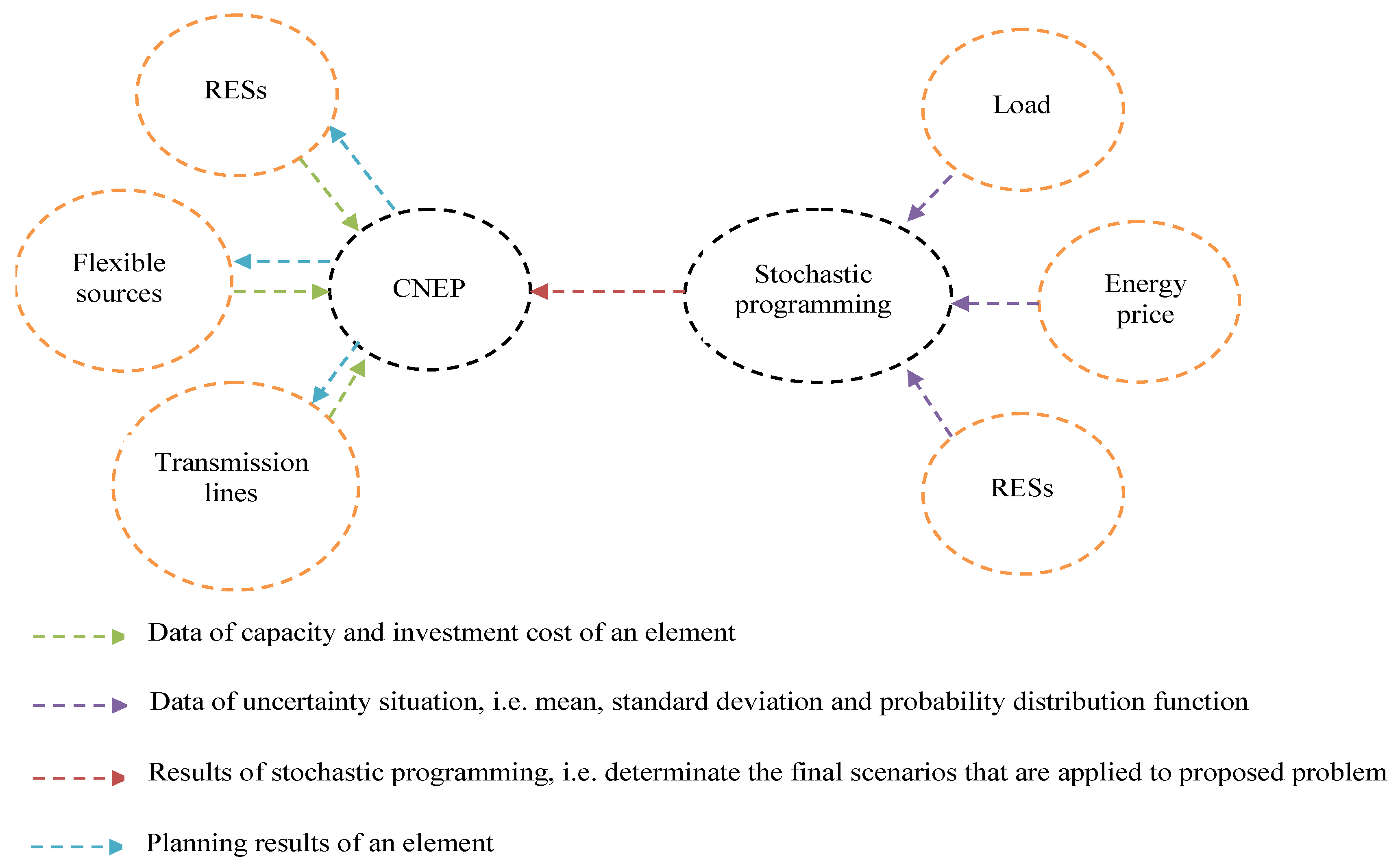
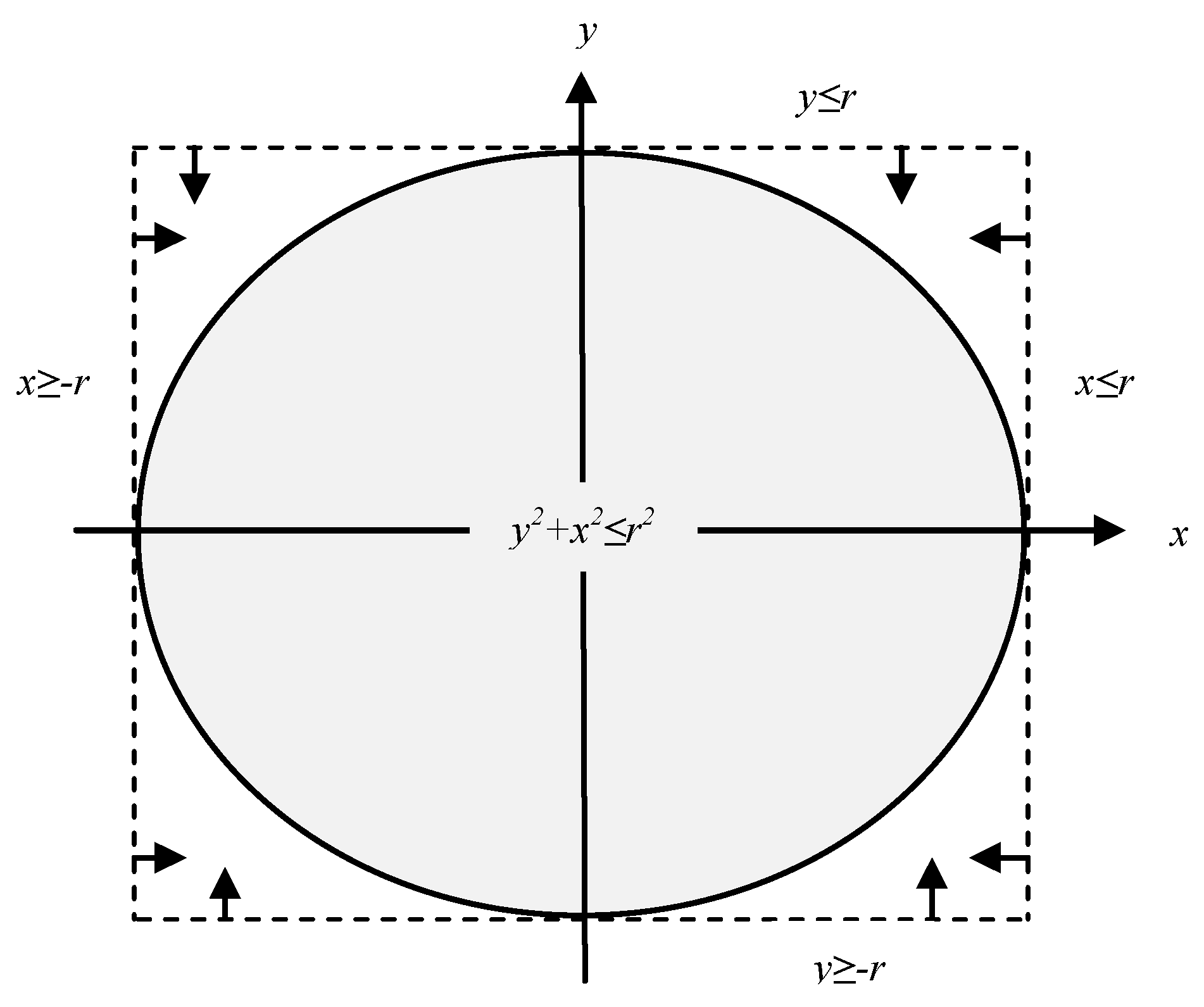
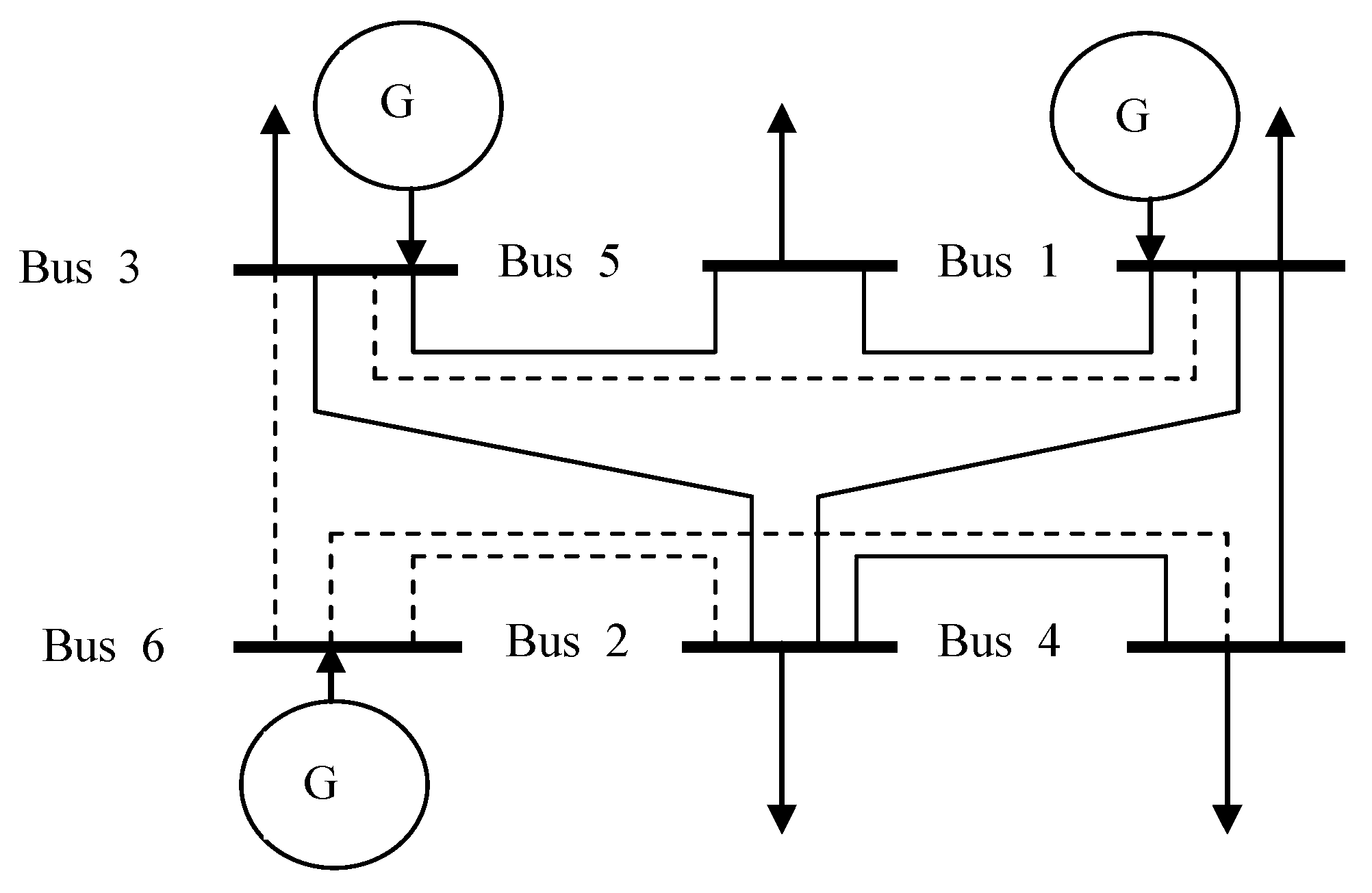
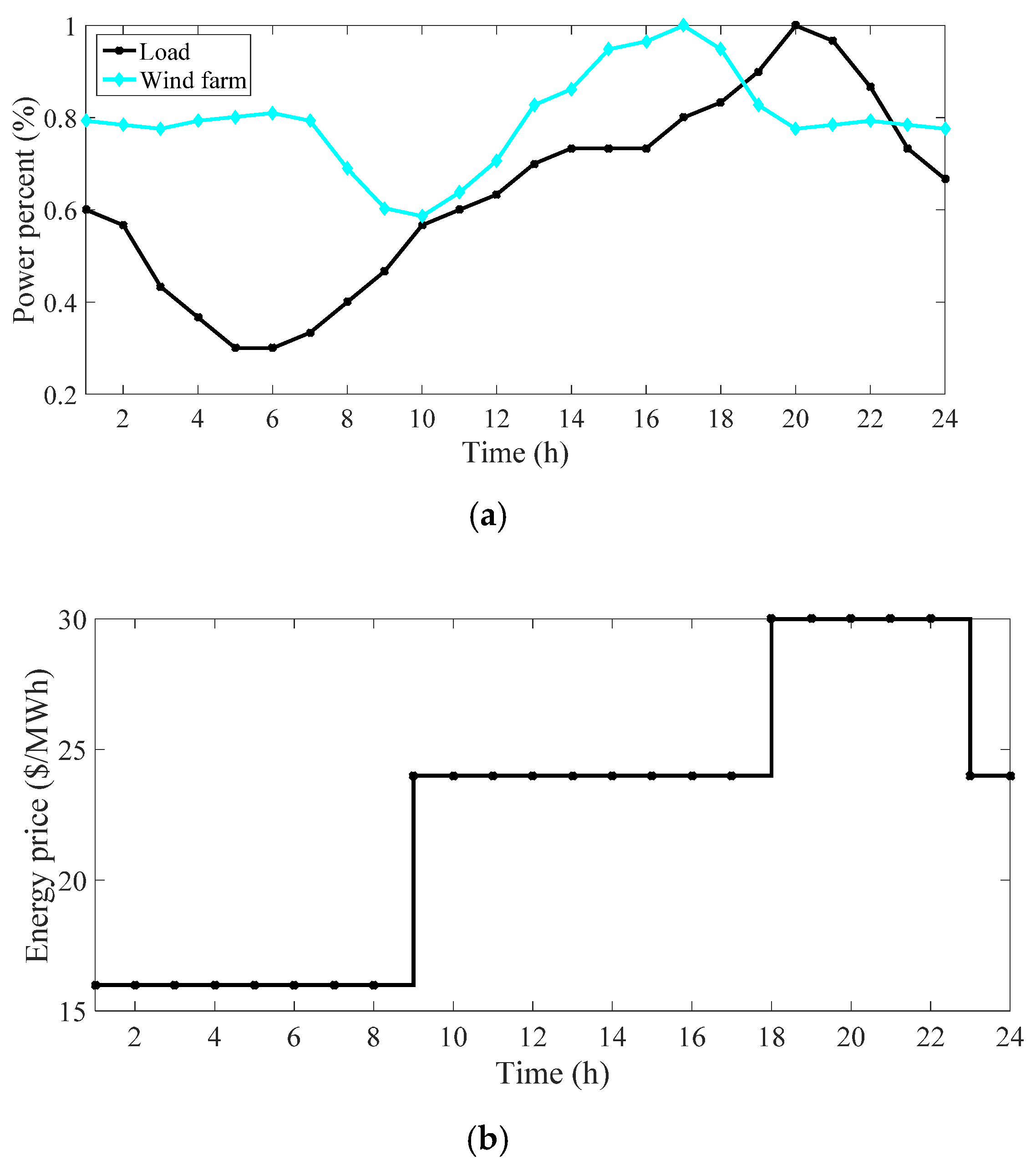
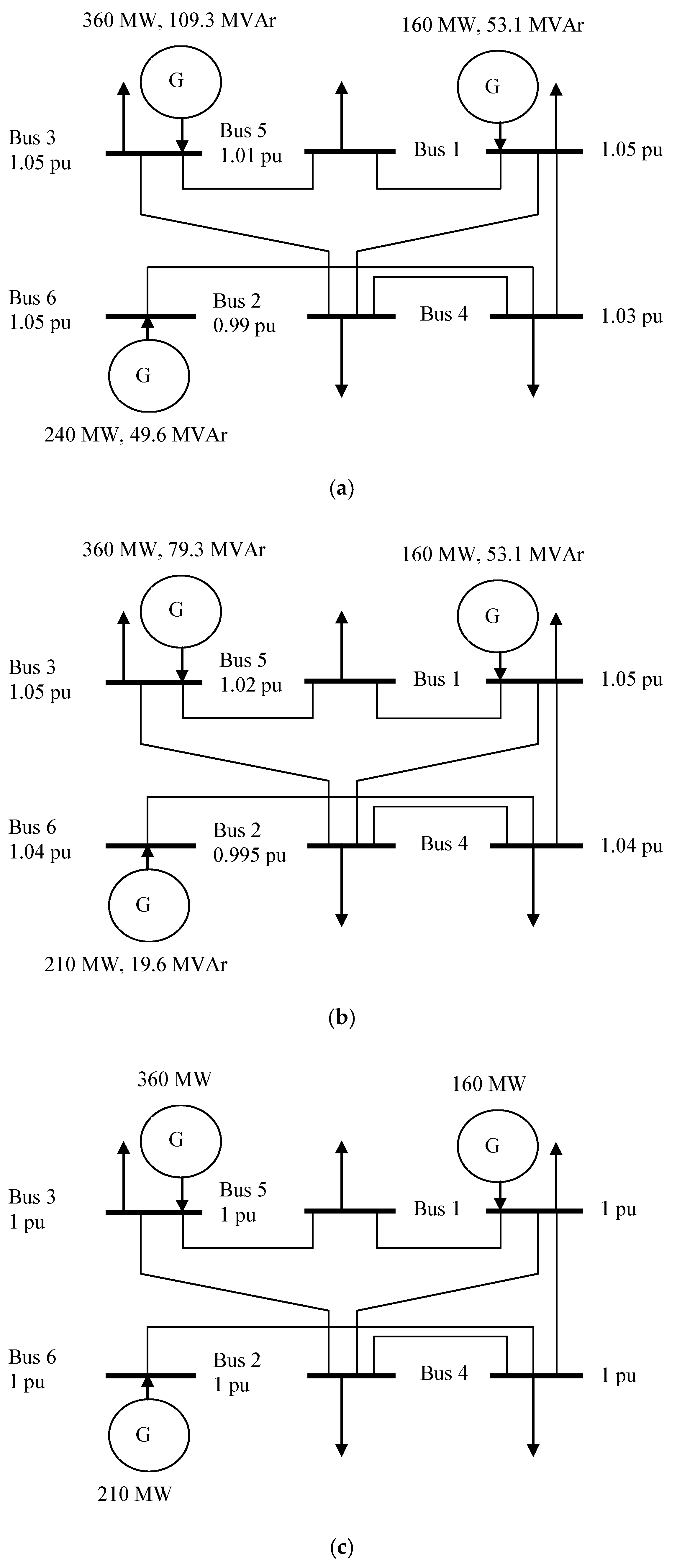


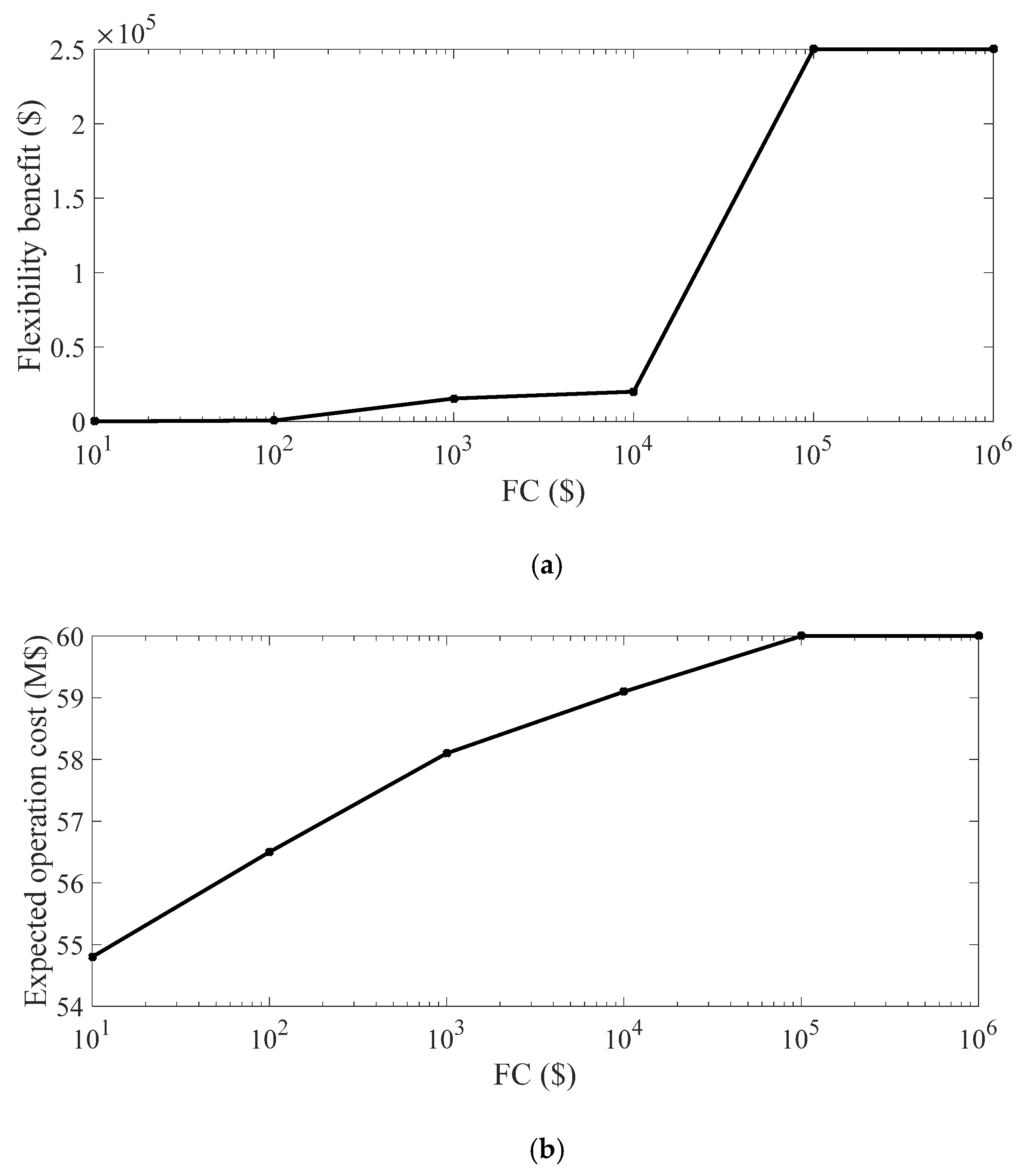
| Bus | Active Load (MW) | Reactive Load (MVAr) |
|---|---|---|
| 1 | 80 | 16 |
| 2 | 240 | 48 |
| 3 | 40 | 8 |
| 4 | 130 | 32 |
| 5 | 240 | 48 |
| Line | From-To Bus | Resistance (pu) | Reactance (pu) | Construction Cost (M$) | Capacity (MVA) |
|---|---|---|---|---|---|
| 1 | 1–2 | 0.04 | 0.4 | 0 | 100 |
| 2 | 1–3 | 0.038 | 0.38 | 38 | 100 |
| 3 | 1–4 | 0.06 | 0.6 | 0 | 80 |
| 4 | 1–5 | 0.02 | 0.2 | 0 | 100 |
| 5 | 2–3 | 0.01 | 0.1 | 0 | 200 |
| 6 | 2–4 | 0.04 | 0.4 | 0 | 100 |
| 7 | 2–6 | 0.01 | 0.1 | 60 | 300 |
| 8 | 3–5 | 0.01 | 0.1 | 0 | 300 |
| 9 | 3–6 | 0.048 | 0.48 | 48 | 100 |
| 10 | 4–6 | 0.01 | 0.1 | 90 | 300 |
| Bus | SGmax (MVA) | Operation Price ($/MWh) |
|---|---|---|
| 1 | 173 | 10 |
| 3 | 390 | 8 |
| 6 | 642 | 12 |
| Year | 1 | 2 | 3 | 4 | 5 |
|---|---|---|---|---|---|
| Load percent | 0.8 | 0.85 | 0.9 | 0.95 | 1 |
| Parameter | DCTEP | NACTEP | LACTEP |
|---|---|---|---|
| Operation cost ($) | 3,062,000 | 3,224,000 | 3,062,000 |
| Investment cost (M$) | 90 | 90 | 90 |
| Total cost (M$) | 93.062 | 93.224 | 93.062 |
| Constructed lines | 4–6 | 4–6 | 4–6 |
| Daily active power Loss (MWh) | 0 | 3.23 | 0 |
| Daily Reactive power Loss (MVARh) | 0 | 5.83 | 0 |
| Computation time (s) | 4 | 432 | 4 |
| Solution situation | Optimal | Local optimal | Optimal |
| Parameter | LACPF |
|---|---|
| Expected operation cost ($) | 3,368,200 |
| Investment cost (M$) | 150 |
| Total cost (M$) | 153.3682 |
| Constructed lines | 2–6, 4–6 |
| Computation time (s) | 5 |
| Solution situation | Optimal |
| Parameter | Case I | Case II | Case III |
|---|---|---|---|
| Total expected operation cost ($) | 3,368,200 | 2,926,000 | 3,045,670 |
| Investment cost (M$) | 150 | 60 | 60 |
| Flexibility benefit (M$) | - | 0 | 0.2186 |
| Constructed lines | 2–6, 4–6 | 2–6 | 2–6 |
| Maximum voltage drop from 1.05 per unit (p.u.) | 0.065 | 0.059 | 0.053 |
| System flexibility | - | 0 | 10.93 |
| Line | 1 | 2 | 3 | 4 | 5 |
|---|---|---|---|---|---|
| Initial-Final bus | 15–21 | 15–24 | 16–17 | 16–19 | 17–18 |
| Construction cost (M$) | 100 | 100 | 100 | 90 | 90 |
| Line | 6 | 7 | 8 | 9 | 10 |
| Initial-Final bus | 17–22 | 18–21 | 19–20 | 20–23 | 21–22 |
| Construction cost (M$) | 100 | 100 | 110 | 100 | 90 |
| Parameter | Value |
|---|---|
| Maximum voltage drop from 1.05 per unit (p.u.) | 0.064 |
| System flexibility | 19.4 |
| Calculation time (s) | 21 |
| Solution situation | Optimal |
Publisher’s Note: MDPI stays neutral with regard to jurisdictional claims in published maps and institutional affiliations. |
© 2021 by the authors. Licensee MDPI, Basel, Switzerland. This article is an open access article distributed under the terms and conditions of the Creative Commons Attribution (CC BY) license (https://creativecommons.org/licenses/by/4.0/).
Share and Cite
Ansari, M.R.; Pirouzi, S.; Kazemi, M.; Naderipour, A.; Benbouzid, M. Renewable Generation and Transmission Expansion Planning Coordination with Energy Storage System: A Flexibility Point of View. Appl. Sci. 2021, 11, 3303. https://doi.org/10.3390/app11083303
Ansari MR, Pirouzi S, Kazemi M, Naderipour A, Benbouzid M. Renewable Generation and Transmission Expansion Planning Coordination with Energy Storage System: A Flexibility Point of View. Applied Sciences. 2021; 11(8):3303. https://doi.org/10.3390/app11083303
Chicago/Turabian StyleAnsari, Mohammad Reza, Sasan Pirouzi, Mostafa Kazemi, Amirreza Naderipour, and Mohamed Benbouzid. 2021. "Renewable Generation and Transmission Expansion Planning Coordination with Energy Storage System: A Flexibility Point of View" Applied Sciences 11, no. 8: 3303. https://doi.org/10.3390/app11083303







